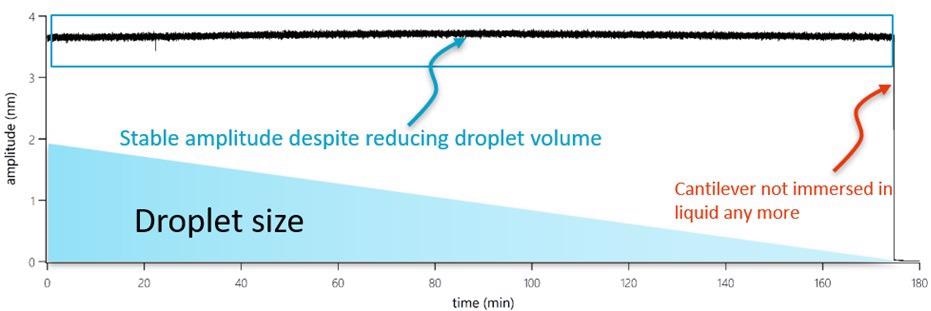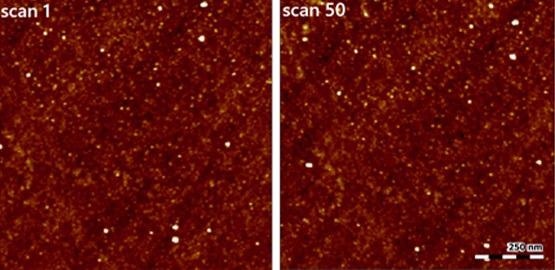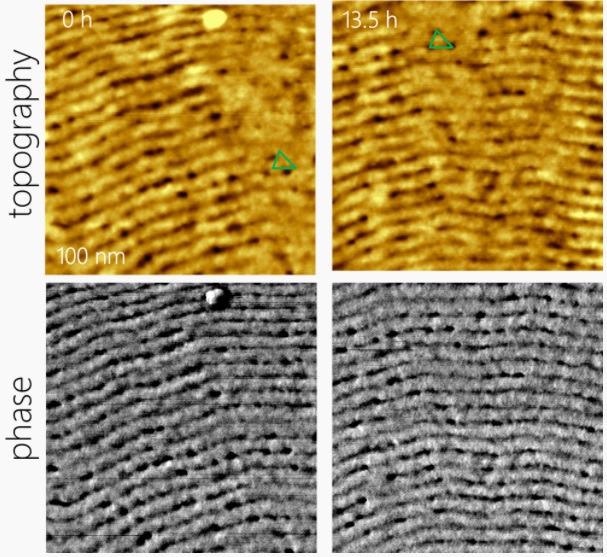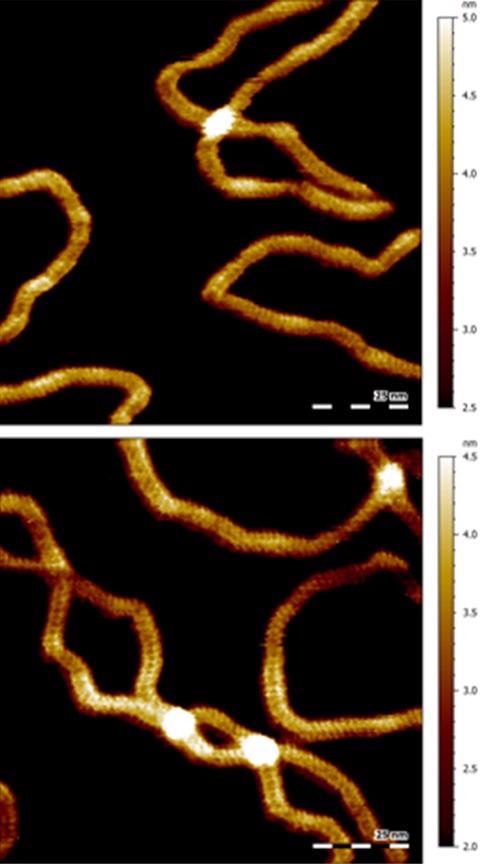Nanosurf presents CleanDrive - a reliable, clean means of oscillating an AFM cantilever while utilizing photothermal excitation. Making use of an IR 785 nm laser directed at the base of the cantilever, CleanDrive is able to provide stable and robust excitation of the AFM cantilever.
This is on top of the 840 nm super luminescent diode light source used for detecting the cantilever deflection. The photothermal excitation of the cantilever offers considerable improvement in usability, resolution, stability and AFM performance, and is particularly efficient in liquid environments.
CleanDrive
AFM modes generally rely on actuating the cantilever and vibrating it at a specific frequency.
Dynamic mode imaging and phase imaging, as well as some of the principal electrical modes, such as electrostatic force microscopy (EFM) and Kelvin probe force microscopy (KPFM), are all contingent on oscillating cantilevers for gentle interaction with the sample. As such, there are two main challenges when using dynamic mode.
The first challenge is obtaining a “clean” frequency sweep with a peak that demonstrates an excellent signal to noise. Typically, the background in the frequency spectrum is noisy due to the fact the piezo-acoustic excitation vibrates not only the cantilever but also the entire cantilever chip, the surrounding environment and the cantilever holder assembly.
This non-targeted excitation of a considerable mass beyond the cantilever of concern is an awkward way to actuate the cantilever and leads to a reduction in performance for a majority of the most popular AFM modes.
The frequency sweep, therefore, detects other peaks related to instrument resonance or cantilever coupling to the cantilever holder. These other peaks may even display a stronger signal to noise than the peak associated with the cantilever’s resonance frequency. This problem is present in all environments and is worse in liquids.
The second challenge of dynamic mode is maintaining steady interaction between the tip and sample. The piezo-acoustic driven frequency spectrum can fluctuate over time, leading to shifts in frequency, phase and amplitude.
This is particularly challenging in the case of liquid imaging, where the extra coupling between the cantilever and its surrounding environment produces a changing forest of peaks superimposed over the highly damped cantilever resonance peak.
As a consequence, the excitation efficiency at a given frequency can significantly fluctuate over time. Thus, photothermal excitation can provide a considerable improvement over traditional “piezo-acoustic” excitation of AFM cantilevers.
CleanDrive offers focused actuation of just the cantilever by harnessing the power of light to induce a bimorph bending effect.
Bimorph bending is a result of the various coefficients of thermal expansions for the two materials on the AFM cantilever - the silicon underside and the metal coating (typically Au or Al) on the top side, whose role is improving the reflectivity of the cantilever for detection and monitoring.
CleanDrive is compatible with all commercial cantilevers in air and fluid and works with small, high-frequency cantilevers. Coated cantilevers are favored as they are more responsive; gold-coated cantilevers are strongly advised for fluid environments due to Al coatings exhibiting limited stability in aqueous solutions.
Frequency Sweep
CleanDrive can offer reliable automatic tuning and clean excitation at an extended range of frequencies. Figure 1a presents a comparison of conventional shaker piezo-driven frequency sweep (in black) and the enhanced photothermal CleanDrive sweep (in red) of an NCSTAuD cantilever in air.

Figure 1. CleanDrive shows textbook-like amplitude response and no “forest of peaks. Image Credit: Nanosurf AG
The first eigenmode is expressed clearly at around 160 kHz in the CleanDrive spectrum. Detection of this peak is not as apparent in the piezo-driven spectrum, which also shows substantial structure in the background.
CleanDrive also offers clear peak detection for the higher order eigenmodes, for instance, the second mode at around 900 kHz. This is in stark contrast to the piezo-driven actuation, where the different eigenmode peaks are clouded by the background structure.
A clean background that facilitates simple, rapid cantilever resonance frequency determination is an even more significant issue in liquid. Figures 1b and 1c respectively show the amplitude and phase plots as a function of frequency for an AC 40 cantilever immersed in a buffer solution.
The CleanDrive frequency spectrum (in red) rapidly determines the damped peak at around 32 kHz, as is shown in Figure 1b.
Comparatively speaking, the shaker piezo-driven sweep demonstrates a number of multiple peak possibilities for this cantilever, such as the doublet between 34 kHz and 38 kHz and peaks at 48 kHz and even 60 kHz.
This so-called “rich” structure - the forest of peaks - in the piezo-excited frequency sweep background is frequently seen in liquids and makes peak identification extremely difficult.
The phase plot (1c) also displays a considerable advantage of CleanDrive over piezo excitation. This phase plot with a clear transition through 0 degrees phase at resonance is necessary for maintaining stable phase imaging and frequency tracking, and it is only observed when using CleanDrive for cantilever excitation in liquid.
Stable Amplitude
Another issue with the oscillation of the cantilever in a liquid environment is that variances in the local environment influence the frequency spectrum stability and thus present a challenge for the effective amplitude of the cantilever.
Figure 2 displays the unparalleled quality of CleanDrive in a fluctuating liquid environment with a cantilever submerged in a 100 µl droplet of buffer and excited with an amplitude of 3.6 nm.

Figure 2. Stable amplitude in a changing environment. Image Credit: Nanosurf AG
Through the application of CleanDrive, the cantilever amplitude remains constant at 3.6 nm for around 3 hours as the droplet evaporates. The amplitude of the cantilever oscillation did not significantly change, in spite of the fact that the surrounding environment changes over time.
Changes in the amplitude were only observed after the droplet had dried enough and the cantilever was no longer submerged in liquid.
Stable Imaging
One of CleanDrive’s most advantageous qualities is long-term stability in imaging. An example of stable imaging is displayed in Figure 3, where the same 1 µm x 1 µm area of a silicon wafer was scanned over 50 times.

Figure 3. Stable imaging of a silicon surface. Image Credit: Nanosurf AG
The surface roughness was determined over the set of images finding no substantial change, suggestive of both stable imaging and preservation of tip sharpness, both thanks to CleanDrive.
Similarly, 100 scans of TipCheck, a notoriously sharp sample, are displayed in Figure 4. TipCheck is generally used to measure the radius and shape of an AFM tip, but it is also renowned for its tendency to rapidly wear down a tip and, as such, should be applied sparingly.

Figure 4. Stable imaging of the TipChecker sample. Image Credit: Nanosurf AG
CleanDrive facilitated continuous scanning of TipCheck sample with no signs of tip degradation. Long-term, stable imaging has a considerable impact on the operation.
Generally, dynamic mode operation requires the user’s constant attention to make adjustments for the continual changes in frequency and amplitude that take place with a piezo-driven oscillation.
Owing to CleanDrive’s excellent reliability and stability of the frequency and amplitude, long-term unattended operation is now an option.
Figure 5 displays 500 nm x 500 nm topography (top) and phase (bottom) images of a polystyrene-polyethylene glycol (PS-PEG) block copolymer film. Originally, an NCST cantilever was set to oscillate with 17 nm amplitude and a setpoint of 86%, which generated the images below.

Figure 5. Long-term stable imaging of block co-polymer samples. Image Credit: Nanosurf AG
The chosen setpoint was 2% below the initial contact made with the surface. Over the course of ~14 hours of continuous overnight measurements, the cantilever persistently maintained contact with the surface and generated images on the right in which the high quality and resolution are retained.
By subsequently increasing the setpoint by the before-mentioned 2%, the cantilever could then be brought out of contact with the surface.
Stable High-Resolution Imaging in Liquids
While each of the examples thus far has demonstrated significant improvements in stability and quality of dynamic mode operation in air, the key advantage of CleanDrive is its capacity for liquid operation.
In Figure 6, two images of DNA on mica in buffer solution are presented. The top image is the first scan, and the bottom image is the 20th consecutive scan. These images demonstrate exceptional resolution that displays the major and minor grooves of DNA without compromising on stability or resolution even after 20 scans without any realignments.

Figure 6. Stable high-resolution imaging of DNA in liquids. Image Credit: Nanosurf AG
Moreover, the near IR wavelength of 785 nm for CleanDrive limits interference with (live) biological samples or fluorescence imaging, making it an optimal choice for photothermal excitation for imaging biological systems.
Summary
CleanDrive utilizes a near IR laser to offer a clean and stable targeted excitation of the AFM cantilever in both air and liquid environments.
This photothermal excitation generates a number of key benefits, including simpler imaging in liquids, enhanced resolution, preservation of tip shape and an increase in the stability of imaging over longer periods of time. These advances will lead to improved results and an enhanced user experience for AFM measurements.

This information has been sourced, reviewed and adapted from materials provided by Nanosurf AG.
For more information on this source, please visit Nanosurf AG.